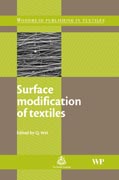
The surface of textiles offers an important platform for functional modifications in order to meet special requirements for a variety of applications. The surface modification of textiles may be achieved by various techniques rangingfrom traditional solution treatment to biological approaches. This book reviews fundamental issues relating to textile surfaces and their characterisation and explores the exciting opportunities for surface modification of a range ofdifferent textiles. Introductory chapters review some important surface modification techniques employed for improved functional behaviour of textiles and the various surface characterisation methods available. Further chapters examine the different types of surface modification suitable for textiles, ranging from the use of plasma treatments and physical vapour deposition to the use of nanoparticles. Concluding chapters discuss surface modification strategies for various applications of textiles. Surface modification of textiles is a valuable resource for chemists, surface scientists, textile technologists, fibre scientists, textile engineers and textile students. INDICE: Surface modification and preparation techniques for textile materials M J John and R D Anandjiwala, CSIR, South Africa Introduction. Natural fibres. Synthetic fibres. Surface preparation techniques for textile materials. Surface modifications techniques for textile materials. Recent studies on modification of textiles. Future trends. References. Textile surface characterization methods Q Wei, F Huang and Y Cai, Jiangnan University, China Introduction. Surface characterization by advanced microscopies. Surface characterization byadvanced spectrometers. Surface wetting and contact angles. Future trends. References. Textile surface functionalization by physical vapour deposition (PVD) Q Wei, Y Wang and Y Xu, Jiangnan University, China Introduction. Working principles of physical vapour deposition. Functionalization of textiles by sputtering. Interfacial bonding. Future trends. References. Surface grafting N Abidi, Texas Tech University, USA Introduction. Techniques of surface grafting. Properties achieved and applications. Strengths and weakness of surface grafting.Future trends. Sources of further information and advice. References. Modification of textile surfaces using electroless deposition S Q Jiang and R H Guo, The Hong Kong Polytechnic University, China Introduction. The techniques and key principles of electroless deposition. Characterisation of electroless copper and nickel-plated polyester fabrics. Strengths and weaknesses of electrolessdeposition. Future trends. Acknowledgements. Sources of further information and advice. References. Textile surface functionalization by chemical vapour deposition (CVD) J Wilson, Heriot-Watt University, UK Introduction. Practical methods for chemical vapour deposition. Characteristics of chemical vapour deposition coatings. Applications. Current trends and potential advances in uses and techniques. Sources of further information and advice. References. Enzyme surface modification of textiles V A Nierstrasz, Ghent University, Belgium Introduction: principles of enzymatic surface modification of textile materials. Enzymes, technologies and materials (natural materials, synthetic materials, biomaterials). Strengths and weaknesses of enzyme surface modification. Future trends. Acknowledgements. References. Modification of textile surfaces using nanoparticles N Vigneshwaran, Central Institute for Research on Cotton Technology, India Introduction. Nanoparticles synthesis and characterization. Functionalproperties using nanoparticles. Commercialization of nanofinishing in textiles. Strengths and weakness of nanotechnology for surface modification. Future trends. References. Modification of textile surfaces using sol-gel technique T Textor, Deutsches Textilforschungszentrum Nord-West e.V., Germany Introduction: the principles of sol-gel-technique. General aspects of textile finishing applying (nano-)sols. Sol-gel-based finishing effects. Future trends. References. Nano-modification of textile surfaces using layer-by-layer deposition methods P Lu, University of California, USA and B Ding, Donghua University, China Introduction. The layer-by-layer deposition technique. Layer-by-layer depositionon textile surfaces. Conclusions and future trends. Acknowledgement. References. Surface modification of textiles for composite and filtration applicationsA S Hockenberger, Uludag University, Turkey Introduction. Surface modification of textiles for composites. Surface properties of reinforcing fibers and applications. Surface modification of textiles for filtration. Applications of surface-modified fibers used for filtration. Future trends. References. Surface modification of textiles by aqueous solutions J Wang, The Procter and Gamble Company USA and J Liu, Zhejiang Sci-Tech University, China Introduction. Mechanisms and chemistries of textile surface modifications. Applications of surfacemodification of textiles by aqueous solutions. Future trends. References. Surface modification of textiles by plasma treatments R R Mather, Heriot-Watt University, UK Introduction. Nature of plasmas. Plasma generation. Low-pressure versus atmospheric-pressure treatments. Strengths and limitations of plasma treatments. Characterisation of plasma-treated textile surfaces. Modifications totextile surfaces. Applications. Future trends. Sources of further informationand advice. References. Emerging approaches to the surface modification of textiles Q Wei, Jiangnan University, China The expansion of textile into technical applications. New techniques for surface modification. Future trends. References.
- ISBN: 978-1-84569-419-7
- Editorial: Woodhead
- Encuadernacion: Cartoné
- Páginas: 352
- Fecha Publicación: 01/08/2009
- Nº Volúmenes: 1
- Idioma: Inglés
